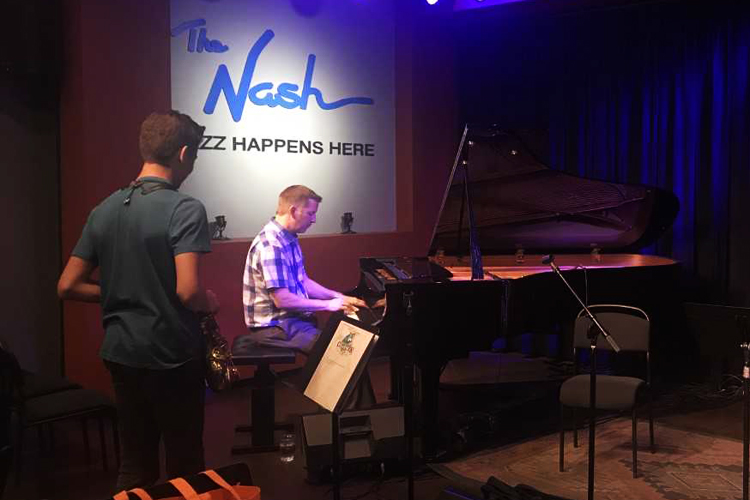When you open the door to The Nash, jazz riffs roar through the room as the jam session gains speed.
When you look to the band throughout the night, you find that sprinkled between the seasoned musicians are several teenagers, just as comfortable and talented as the professionals beside them. The longer they play, the better the music gets.
Named after its founder Lewis Nash, The Nash jazz club opened at 110 E. Roosevelt St., in Phoenix in April 2012. It has been deemed one of the best jazz venues in the world five times by Downbeat Magazine. The Nash is known best for the community of jazz lovers it has created, but it is becoming better known for teaching young generations the art of playing jazz.
“Jazz education and music education in general is not just about the music,” said Dr. Benjamin Hedquist, the Education Program Coordinator at The Nash. “You learn a lot of skills that allow you to be a contributing member of society. And that’s why it’s important.”
The Nash has several ensembles and workshops aimed solely at student musicians. The Vocal Ensemble, directed by Dr. Greg Amerind, gives vocalists the chance to hone their skills in a group setting.
The two Legacy Ensembles, directed by Mike Kocour and Eric Rasmussen, teach instrumentalists how to blend with other musicians as well as how to stand out with their improvised solos.
“These students come in every week and they’ve got new questions,” Kocour said. “They’re just anxious to demonstrate that they’ve gotten better.”
For some of the students in the program, The Nash’s ensembles are the only music education they can get.
Tiger Bunch, 17, is the drummer in one of the Legacy Ensembles. This is his second year in a Legacy Ensemble at The Nash.
“It’s complicated for me because my school doesn’t have any music program to speak of,” Bunch said. “I really have to pursue music outside of school. Things like this are absolutely amazing for me.
This year, The Nash also introduced The Futures Workshop, directed by Pam Morita. The Futures Workshop focuses on teaching improvisation to students who are brand new to the practice. Its goal is to improve improvisation and give the students a better chance of being selected for the higher ensembles.
“I love when the light bulb goes off and there’s receptivity,” Morita said. “You get to see them really get into it.”
Arianna Green, 15, is one of Morita’s students. She plays the tenor saxophone and is a part of her high school’s jazz program. This is her first semester at The Nash.
Green has found that at The Nash, there is more time for the teachers to answer her questions, particularly those about music theory.
“You really get that one-on-one conversation,” she said. “My favorite part has been being able to have the notes and the phrases to express myself.”
As The Nash continues to add and expand elements of its education program, it has a very clear objective for the final outcome.
“We’ve created a kind of pipeline,” Hedquist said. “The students can work their way up the chain to be in the Legacy Ensembles.”
The Nash’s education program works to focus on the individual and improve the students’ abilities, putting the needs of the students before all else.
“We don’t have these ensembles just to have good ensembles to make The Nash look good,” Hedquist said. “We have these ensembles so we can better the students and help them progress.”
The Nash also provides opportunities to young musicians not directly affiliated with its programs. It hosts weekly jam sessions that are open to the community and students from all over the Valley are encouraged to attend.
These jam sessions give students “a chance to fail,” according to local pianist and jazz clinician Russell Schmidt. “It allows for increased learning.”
The Nash also hosts the Emerging Artists Program, a summer concert series that allows talented young musicians from around the state to plan and lead their own gigs at The Nash.
“They do this to give them a shot at being a leader,” Schmidt said. “There’s a certain amount of mentoring that helps get young musicians ready to front a gig for the first time.”
Leading a gig is impressive for any musician, and having the chance to do so at such a young age and at such a renowned venue allows the artists to get the experience they need to kick-start their careers.
The Nash also works to encourage a love for jazz in young audiences with the hope that they will go on to support jazz as adults.
The monthly Hot Dogs and Jazz event gives young children a chance to experience jazz music while having a fun morning with their families.
“The idea is to build this community of musicians and music lovers,” Hedquist said. “It’s unifying.”
It only takes one visit to The Nash to discourage the belief that jazz is a dying art form. Every year, The Nash’s education program grows and reaches more young musicians, encouraging them to join the mission to spread jazz as far as it can be spread.
“We hope that the students come out of our program and bring some of that experience back to the students at their schools,” Kocour said. “They are not just learning it for them. They are passing it along.”




